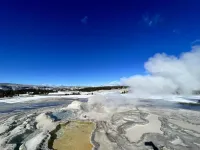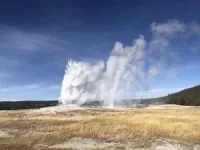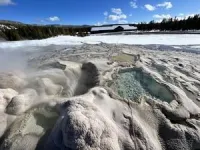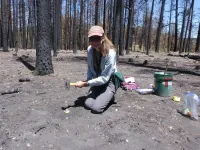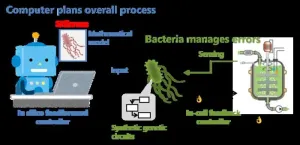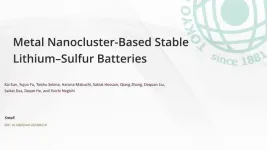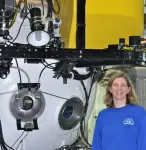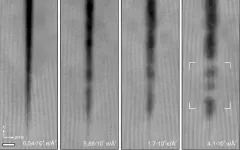(Press-News.org) Contributed by Arianna Soldati, GSA Science Communication Fellow
Pittsburgh, Pa., USA: An eruption of Old Faithful Geyser in Yellowstone National Park is a sight to behold. Indeed, millions of tourists flock to the park each year to see it. Hot water and steam are ejected in the air to a height of 100–180 feet approximately every 90 minutes. Many adjectives come to mind to describe it: powerful, mesmerizing, unique, otherworldly . . . homey? Not so much. Yet new research by Lisa M. Keller, published on PNAS Nexus earlier this year and to be presented on Sunday at the Geological Society of America’s GSA Connects 2023 meeting, shows that for some microbial life forms, Old Faithful Geyser is exactly that: home.
Meet Thermocrinis ruber and Thermus aquaticus. Thermocrinis ruber is the most abundant bacterium residing in Old Faithful, making up over 60% of the microbial population. As a chemoautotroph, it makes its own energy, not only for its own sustenance, but also to the benefit of the rest of the microbial community. But how? Old Faithful is a dark, hot place, which makes photosynthesis impossible. Instead, Thermocrinis ruber takes CO2 outgassing from the geyser and turns it into carbon forms that are potentially cross-feeding heterotrophs in the community, such as Thermus aquaticus.
Both bacteria are extremophiles—life forms that thrive where most would not survive. Whatever the challenging environmental factor, there are microbes adapted to overcome it. Hypersaline pools? Check. Lack of oxygen? You bet. Scorching hot water? Not a problem.
Geysers present a unique challenge: they are extremely dynamic environments. As if being thrown hundreds of feet in the air every 90 minutes isn’t disruptive enough, the microbes are subject to fluctuating steam and water temperatures that constantly change throughout the eruption cycle.
In every challenge there is an opportunity, and Old Faithful’s thermal excursions and eruptions are no exception. More strains of Thermocrinis are found in Old Faithful than in any other non-geysing hot spring in Yellowstone. “We think that the highly dynamic geyser environment creates many different ecological niches that Thermocrinis can occupy, causing increased sub-species level diversity,” says Keller. These findings show not only that Old Faithful Geyser is habitable, but also that its dynamic environment promotes genomic diversity.
In order to prevent any possible sample contamination, Keller collected geysed water as it was falling from the eruption in weighted sterile bins. Ten minutes after the end of the eruption she would walk out to the cone with a National Park Service escort and retrieve the precious samples. Additionally, she sampled a pool fed exclusively through Old Faithful’s eruptions.
Once back in the laboratory, Keller incubated the samples at different temperatures representative of geyser and pool conditions. The objective? Monitor the microbial activity to verify that the sampled bacteria would really be active at those extreme temperatures. And active they were, to Keller’s delight. “They immediately showed signs of activity, suggesting there is active microbial life in Old Faithful waters!” says Keller.
Beyond Earth, geysers are of extreme interest to the planetary community, as active geyser eruptions have been observed on the moons Enceladus and Europa. “Everybody gets excited about sampling Enceladus plumes,” says Keller, “but prior to this work we didn’t even have terrestrial geysers microbial samples. I thought, let’s take a step back and figure it out on our own planet first.” Sampling planetary geysers may still be a long way off, as the current methodology requires filtering liters and liters of water—something that would certainly be challenging away from Earth—but now that we know for sure that terrestrial geysers can host life, the race to find it on planetary geysers is on too.
An Active Microbiome in Old Faithful Geyser
Author: Lisa M. Keller, Montana State University, lkeller02@gmail.com
https://gsa.confex.com/gsa/2023AM/meetingapp.cgi/Paper/390179
Sunday, 15 October 2023, 8:05–8:25 a.m.
The Geological Society of America (https://www.geosociety.org) unites a diverse community of geoscientists in a common purpose to study the mysteries of our planet (and beyond) and share scientific findings. Members and friends around the world, from academia, government, and industry, participate in GSA meetings, publications, and programs at all career levels, to foster professional excellence. GSA values and supports inclusion through cooperative research, public dialogue on earth issues, science education, and the application of geoscience in the service of humankind.
# # #
END
Extreme habitats: Microbial life in Old Faithful Geyser
New research presented at GSA Connects 2023
2023-10-12
ELSE PRESS RELEASES FROM THIS DATE:
Inferring wildfire intensity from quartz luminescence
2023-10-12
Pittsburgh, Pa., USA: On 8 June 2020, the Mangum Fire ignited 16 miles north of the North Rim of Grand Canyon National Park. By the time it was mostly contained, about a month later, the fire had burned over 70,000 acres of land.
April Phinney, a M.Sc. candidate at Utah State University, immediately started drafting a burn intensity map based on remote sensing data. Six months later, she set boots on the burned ground and started collecting soil samples, hoping they would contain quartz grains. This research ...
Cancer Prevention and Research Institute of Texas awards grants to four TTUHSC Researchers
2023-10-12
The Cancer Prevention and Research Institute of Texas (CPRIT) recently awarded grants to four researchers from the Texas Tech University Health Sciences Center (TTUHSC). Combined, the grants will provide nearly $2.3 million that TTUHSC will use to conduct a pair of two-year pilot studies, acquire a state-of-the-art piece of laboratory equipment known as a cell sorter, and administer a colorectal cancer screening and prevention program.
Three of the recipients are from the TTUHSC School of Medicine, including Hongjun (Henry) Liang, Ph.D., a professor in the Department of Cell Physiology and Molecular Biophysics; Min Kang, Pharm.D., a professor ...
Proof-of-concept method advances bioprocess engineering for a smoother transition to biofuels
2023-10-12
One of the primary goals of bioprocess engineering is to increase the yield of the desired material while maintaining high production rates and low raw material utilization. This optimization is usually accomplished by controlling the behavior of microorganisms used in the process and ensuring that their biological capabilities are fully utilized. This control may be computerized (in silico feedforward) or autonomous (in-cell feedback) which predicts the optimization based on inputs received. However, a process-model mismatch (PMM) occurs when there is a discrepancy between the predicted and actual production processes.
A recent paper published in Scientific Reports demonstrates a ...
Revolutionizing energy storage: Metal nanoclusters for stable lithium–sulfur batteries
2023-10-12
The demand for efficient energy storage systems is ever increasing, especially due to the recent emergence of intermittent renewable energy and the adoption of electric vehicles. In this regard, lithium–sulfur batteries (LSBs), which can store three to five times more energy than traditional lithium-ion batteries, have emerged as a promising solution.
LSBs use lithium as the anode and sulfur as the cathode, but this combination poses challenges. One significant issue is the “shuttle effect,” in which intermediate lithium polysulfide ...
Toward a global scientific consensus: identifying vulnerable marine ecosystems through imagery
2023-10-12
The scientific community is taking a significant step towards establishing a consensus on the designation of Vulnerable Marine Ecosystems (VMEs) from imagery data, as highlighted in the new article titled "Towards a scientific community consensus on designating Vulnerable Marine Ecosystems from imagery," authored by Dr. Amy R. Baco and colleagues, and published in PeerJ Life & Environment.
“Many scientists around the world were working independently on a similar question: Given the UN Food and Agriculture Organization (FAO) regulations for deep-sea Vulnerable Marine Ecosystems ...
Surprising discovery shows electron beam radiation can repair nanostructures
2023-10-12
MINNEAPOLIS / ST. PAUL (10/12/2023)—In a surprising new study, researchers at the University of Minnesota Twin Cities have found that the electron beam radiation that they previously thought degraded crystals can actually repair cracks in these nanostructures.
The groundbreaking discovery provides a new pathway to create more perfect crystal nanostructures, a process that is critical to improving the efficiency and cost-effectiveness of materials that are used in virtually all electronic devices we use every day.
“For ...
UTSA study could remove carbon emissions from atmosphere
2023-10-12
Zachary Tonzetich, an associate professor in the UTSA College of Sciences’ chemistry department, is part of a duo that has been awarded a one-year, $100,000 grant from The Welch Foundation for a project that could remove carbon emissions from the atmosphere.
Tonzetich and his research collaborator Anthony Cozzolino, an associate professor in Texas Tech University’s chemistry department, were the recipients of a WelchX pilot grant this past August. The WelchX program brings together leading chemistry researchers from across Texas to address challenging issues that are ...
New research shows why hunting for the cheapest plane ticket is a waste of your time
2023-10-12
Buy your ticket on a Tuesday. Search in your browser’s incognito mode. Use a VPN to pretend you live in Suriname.
“There are so many hacks out there for finding cheaper airline tickets,” says Olivia Natan, an assistant professor of marketing at the Haas School of Business. “But our data shows many of these beliefs are wrong.”
With four colleagues—Ali Hortaçsu and Timothy Schwieg from the University of Chicago, Kevin Williams from Yale, and Hayden Parsley from the University of Texas at Austin—Natan looked deeply into the structure and processes behind how ...
Commonly prescribed hypertension drug, amlodipine, not actually dangerous
2023-10-12
A new paper in the journal Function, published by Oxford Univetrsity Press, finds that a widely prescribed drug for treating hypertension, amlodipine, is not dangerous for patients, despite recent concerns from researchers and clinicians that taking amlodipine may have risks.
Approximately 700,000 Americans die from hypertension each year and researchers believe some 116 million Americans (and one in five adults worldwide) have the disease, which is responsible for 7.6 million deaths per year. If untreated, hypertension significantly increases ...
Cycling in school improves teenagers’ mental health, but wider social factors may impact benefits
2023-10-12
Physical activity has positive effects on mental health and yet, activity rates are declining. This is particularly worrying because the mental well-being of teenagers continues to deteriorate. In the US, one in six school children is diagnosed with some type of mental disorder.
Riding bikes is a promising approach to introduce school-aged children to physical activity. Now, researchers in the US have investigated how adolescents’ psychosocial well-being changed after participating in a school-based cycling program.
“Participation in a school cycling education program during the Covid-19 pandemic was associated with improved psychosocial well-being amongst middle schoolers in the ...
LAST 30 PRESS RELEASES:
Heart-brain connection: international study reveals the role of the vagus nerve in keeping the heart young
Researchers identify Rb1 as a predictive biomarker for a new therapeutic strategy in some breast cancers
Survey reveals ethical gaps slowing AI adoption in pediatric surgery
Stimulant ADHD medications work differently than thought
AI overestimates how smart people are, according to HSE economists
HSE researchers create genome-wide map of quadruplexes
Scientists boost cell "powerhouses" to burn more calories
Automatic label checking: The missing step in making reliable medical AI
Low daily alcohol intake linked to 50% heightened mouth cancer risk in India
American Meteorological Society announces Rick Spinrad as 2026 President-Elect
Biomass-based carbon capture spotlighted in newly released global climate webinar recording
Illuminating invisible nano pollutants: advanced bioimaging tracks the full journey of emerging nanoscale contaminants in living systems
How does age affect recovery from spinal cord injury?
Novel AI tool offers prognosis for patients with head and neck cancer
Fathers’ microplastic exposure tied to their children’s metabolic problems
Research validates laboratory model for studying high-grade serous ovarian cancer
SIR 2026 delivers transformative breakthroughs in minimally invasive medicine to improve patient care
Stem Cell Reports most downloaded papers of 2025 highlight the breadth and impact of stem cell research
Oxford-led study estimates NHS spends around 3% of its primary and secondary care budget on the health impacts of heat and cold in England
A researcher’s long quest leads to a smart composite breakthrough
Urban wild bees act as “microbial sensors” of city health.
New study finds where you live affects recovery after a hip fracture
Forecasting the impact of fully automated vehicle adoption on US road traffic injuries
Alcohol-related hospitalizations from 2016 to 2022
Semaglutide and hospitalizations in patients with obesity and established cardiovascular disease
Researchers ‘listen in’ to embryo-mother interactions during implantation using a culture system replicating the womb lining
How changing your diet could help save the world
How to make AI truly scalable and reliable for real-time traffic assignment?
Beyond fragmented markets: A new framework for efficient and stable ride-pooling
Can shape priors make road perception more reliable for autonomous driving?
[Press-News.org] Extreme habitats: Microbial life in Old Faithful GeyserNew research presented at GSA Connects 2023
